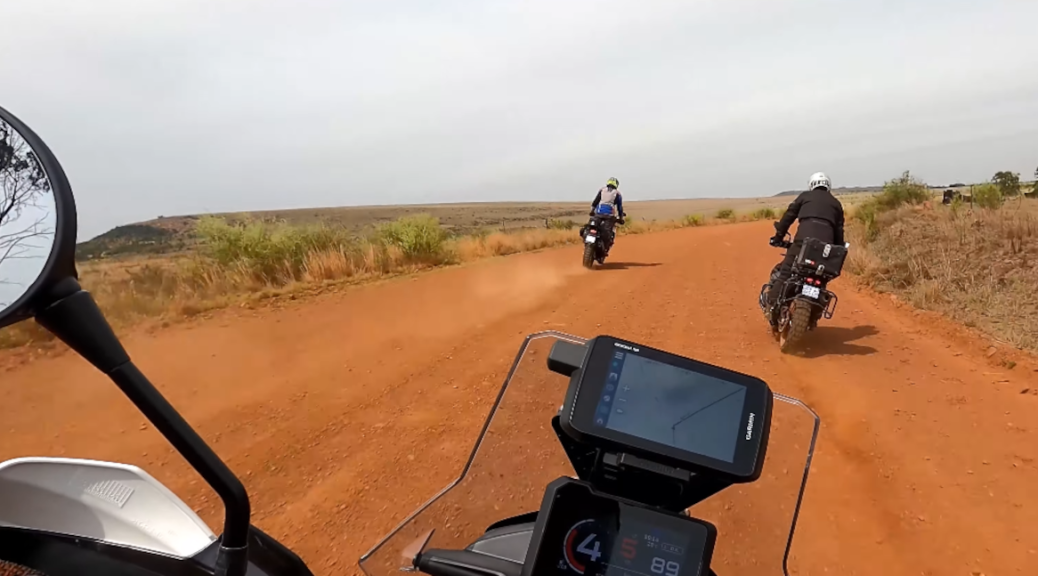A motorcycle trip built around the Waterberg offers routes that maximise gravel travel. Add in one-of-a-kind refreshment and overnights stops and you have adventure biking at its best. Tracks4Africa user Willem Rudolph reports back on a three-day adventure.
Three days of riding along gravel roads. Game viewing from the back of a bike. Pitstops at quirky bush pubs and overnighting in wild places. Adventure biking in the North West and Limpopo is highly recommended, says Willem Rudolph, yet it wasn’t his first choice.
“I tend to look further afield because all the well-known rides seem to be far away from us in Johannesburg. You’ve got to go into the Karoo, along the West Coast or into the Kalahari. Logistically it’s a mission, because it normally takes a day to get there and another to get back,” he says. But since not everyone has the appetite or time to cover such long distances on a motorbike, he started looking at what’s around Gauteng.
Willem knew of a magical place to stay in the Waterberg: a riverside camp on a farmer’s land. Scanning the map between there and Johannesburg, his eyes hit upon the Brits area, where canals criss-cross the farmlands. Good quality gravel roads lead alongside these canals, offering hours of scenic riding. “The Canal Route is well known among mountain bikers, adventure bikers and offroaders.” The trip was starting to take shape.
Sitting down with Tracks4Africa maps, he plotted a three-day route along gravel roads. After many hours of scrutinising the map, he found a way to spend 90% of the time on gravel. Taking a wide loop through the North West, the route would skirt the Botswana border before turning east towards the Waterberg. From there, the adventure bikers would head south to Hartbeespoort and home.
The adventure begins
On 3 November 2023, a group of five adventure bikers set off on the Waterberg gravel adventure. Willem and his usual wingman, Andrew Miller, were joined by three other riders. Ricardo Bendana is an expat from Central America determined to see as much of South Africa as possible. Floyd Preston is a keen dirt biker who hadn’t done a multi-day adventure biking trip before. And Dwain Barnard had been planning to ride in the Dakar Rally, but had to pull out due to injury, so was at a loose end.
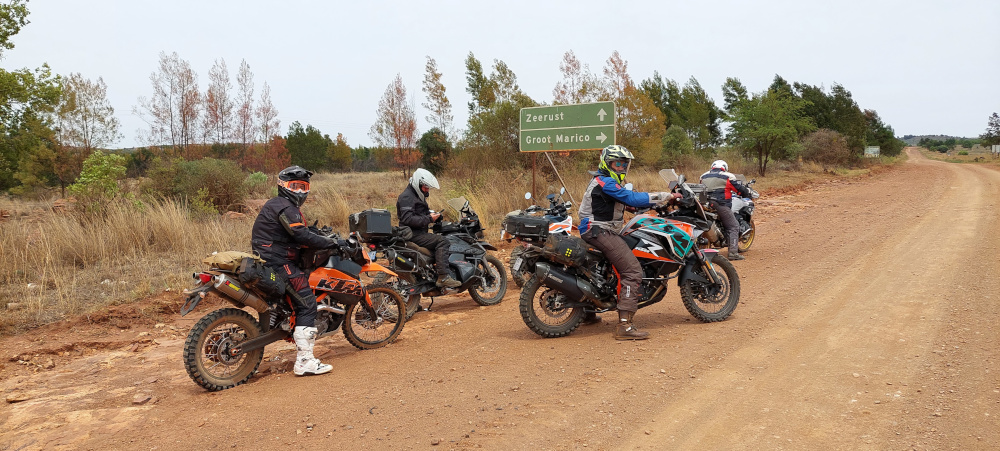

“When I was planning the trip, I figured we would be riding dirt roads for three days, which would be cool. But the trip surpassed my expectations. For most of the way, we had superb dirt roads and the landscape was massively varied. We rode through grasslands, farmlands, valleys and mountainous areas.”
Day 1: Tarlton to Derdepoort (316km)
Leaving Johannesburg in the morning, the adventure bikers stood out among the commuters on their way to work. They hit the gravel at Tarlton, where open, flowing dirt roads made for good speed and they could ride together as a group.
Barely 50km on, Willem had a close encounter with a rare white blesbok. “I was coming up a hill and the buck was hidden against the background of the dirt road. Suddenly, I saw this movement in the foreground and realised there was an animal running towards me. I thought it might end badly for us.” Fortunately, Willem could slow down and avoid the blesbok, but it brought home the nature of the trip.
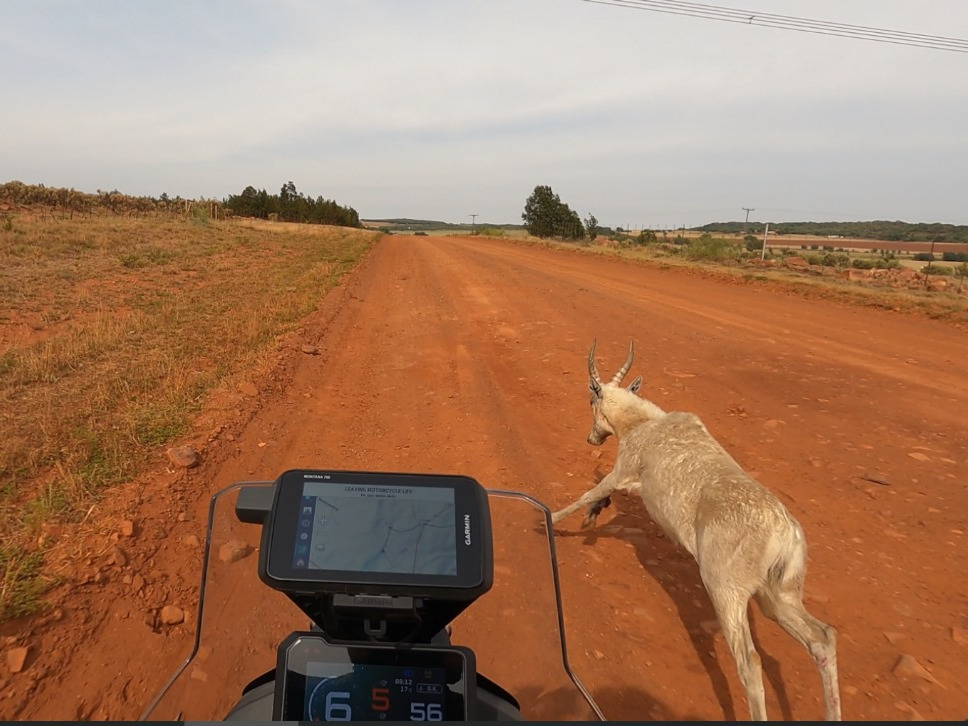
Riding in remote areas brings adventure bikers into close range of cattle and wildlife. Animals might not be used to the sound of motorbikes and there’s a chance of insufficient fencing. “While we do this to relax and to get away from stuff, you’ve got to be aware of your surroundings and your speed. The faster you ride, the bigger the risk,” he says.
Just before Groot Marico, they entered an area known as Doringkloof, with the pass causing the bikers to spread out more. “Down in the valley, it’s narrow, it’s gnarly, there’s a lot of rock. So the riding style has to be a bit different. And then you suddenly get spat out into this little forgotten town.”
Setbacks on the way
Groot Marico was the group’s first refuelling stop. When you ride in the back country, it’s vital to pinpoint where you can get fuel. Fortunately, Tracks4Africa maps identify the places where you can fill up. “When we got into Groot Marico to refuel, Andrew told me his KTM was boiling. Dwain and Andrew proceeded to strip the entire bike and we spent two hours at the garage. However, they didn’t manage to find the problem and we had to leave because time was becoming an issue. The Golden Rule is that you don’t drive after dark.”
The group pushed on, everyone carrying extra water in order to refill the radiator. An alleged bush fix for a leaking radiator is to use curry powder and they thought it was worth a try. “I don’t know what the spaza owner thought when five bikers stormed in looking for curry powder,” laughs Willem.
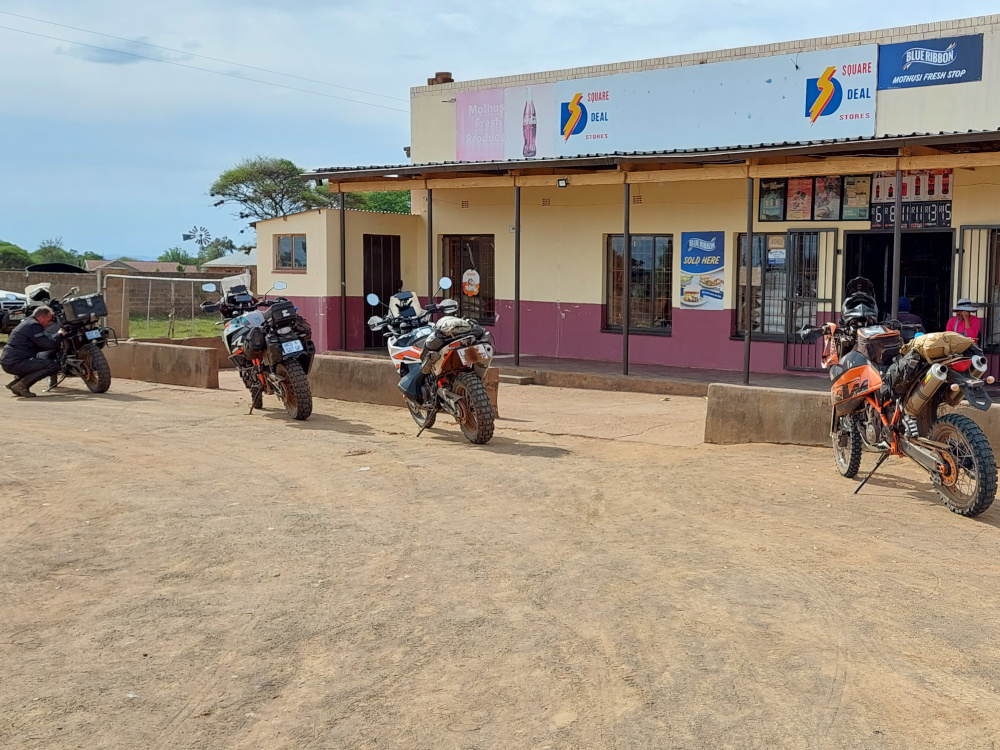
They rode right up to Botswana in order to refuel at the Derdepoort border post. From there it was just 5km to their overnight spot at Motsomi Safaris. Willem had initially struggled to find affordable accommodation in this area known for its game lodges. However, as a hunting concession catering to Americans, Motsomi was closed for the season. The friendly manager was willing to let the adventure bikers camp there.
“As we pulled away from the border post, Dwain suffered a catastrophic puncture to his rear wheel. We all carry puncture kits with us, but because his is a competition bike, it couldn’t be as easily fixed.” The day ended at Motsomi’s luxurious camp, with two of the bikers – Dwain and Andrew – knowing their trip had come to an end.
Day 2: Motsomi Safaris to Waterberg Farmstay (254km)
On the second day, the route ran along the border with Botswana and the track was well graded. There were long, open stretches as they rode on border lines between farms, so the remaining three bikers could open the throttle.
But as they headed towards the point where they would turn east, they came upon a large section of deep sand. “It was about 20km of sand; the entire stretch seemed to be in a riverbed. We immediately slowed down and were wrestling with the bikes, trying to get through the sand. It was really hot and you could see the energy drain out of everyone,” recalls Willem.
Fortunately, around this time they could also see massive black clouds rolling in from Botswana. “We got drenched but, with a bit of speed (after the sandy stretch), we dried out quickly. It also cooled us down nicely and the rain settled into a drizzle, just enough to keep the dust down.”
The game viewing on the way into the Waterberg was spectacular. Aside from graceful giraffes, the bikers also saw herds of black springbok and golden wildebeest. Because this area is so game rich, it’s also highly protected to guard against poaching. As the road led just north of Marakele National Park, there were several control gates to contend with. Then, another hiccup. On a sandy section, Ricardo lost his footing and put his BMW GS down. “We were all struggling, but his is a much heavier bike. He wasn’t hurt, luckily. He caught his breath, picked up the bike and off we went.”
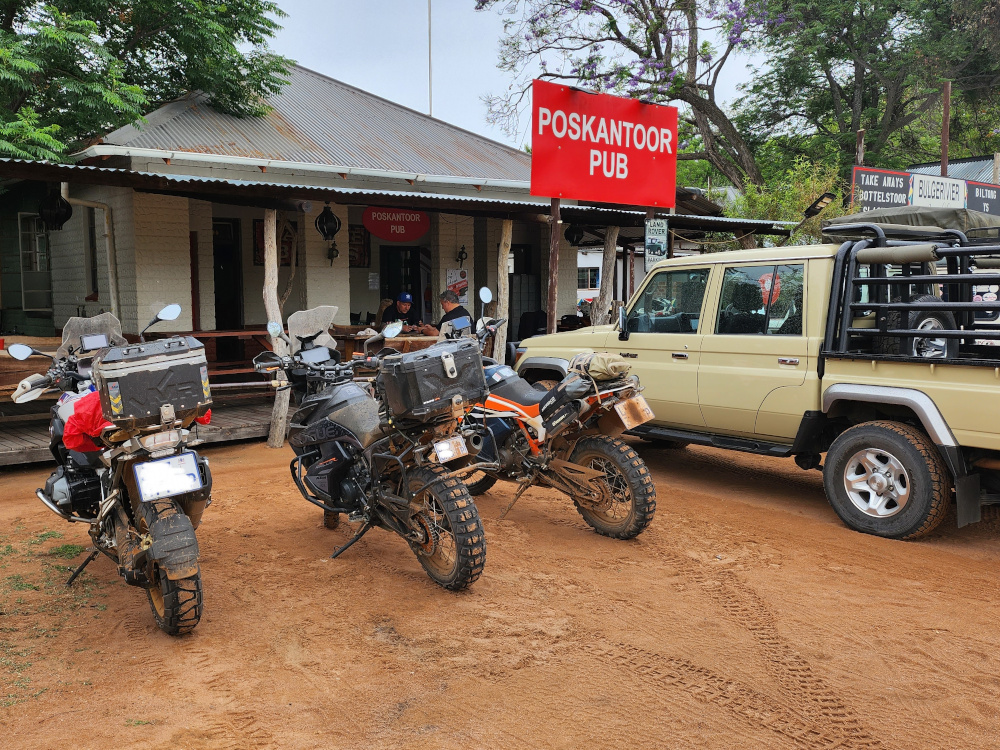
By the time they reached the Poskantoor Pub in Lephalale, they were properly exhausted. They had an early dinner before continuing to Waterberg Farmstay for the night.
Day 3: Waterberg Farm Stay to Hartbeespoort (346km)
After a brief detour to Vaalwater to refuel, Willem and his friends headed back into the hills. “It was very pretty and varied terrain, from sand to hardpack,” he says. On the section leading up to Rankin’s Pass, the surface was covered in loose pebbles, so that it was like “riding on marbles”. “You have little control over the steering and the bike tends to drift. But momentum is your friend: just aim the bike in a direction and keep going. Don’t accelerate or slow down too quickly,” he advises.
The third day had another challenge in store in the stretch towards Rooiberg. “It’s the bumpiest road I’ve ever ridden. Perhaps they haven’t graded it for 10 years. It feels like the eyeballs in your head are going to shake loose.” But all that rattling and shaking finally brought the bikers to the Koekepan Pub and brunch.
From there on it was easy riding through flowing landscape towards Brits. “We covered this part quite quickly because of the straight sections of gravel. We then decided to follow the canals. This bit’s very twisty and turny, so you’re constantly accelerating, braking and decelerating. We ended up losing the route and passing through some farmer’s property.” The bikers managed to reconnect with the so-called Canal Route, but when they came to a tar road intersection with about 40km of dirt left, they decided to call it a day.
“More than 300km is long when it’s just normal riding, but the Canal Route is challenging. It could be a one-day ride on its own,” he says.
Reflecting on the route
Willem’s gravel adventure through the North West and Limpopo turned out even better than expected:
• Riding locally didn’t involve a massive amount of organisation and could be done over a long weekend.
• It delivered awe-inspiring scenery, fantastic game sightings and varied riding.
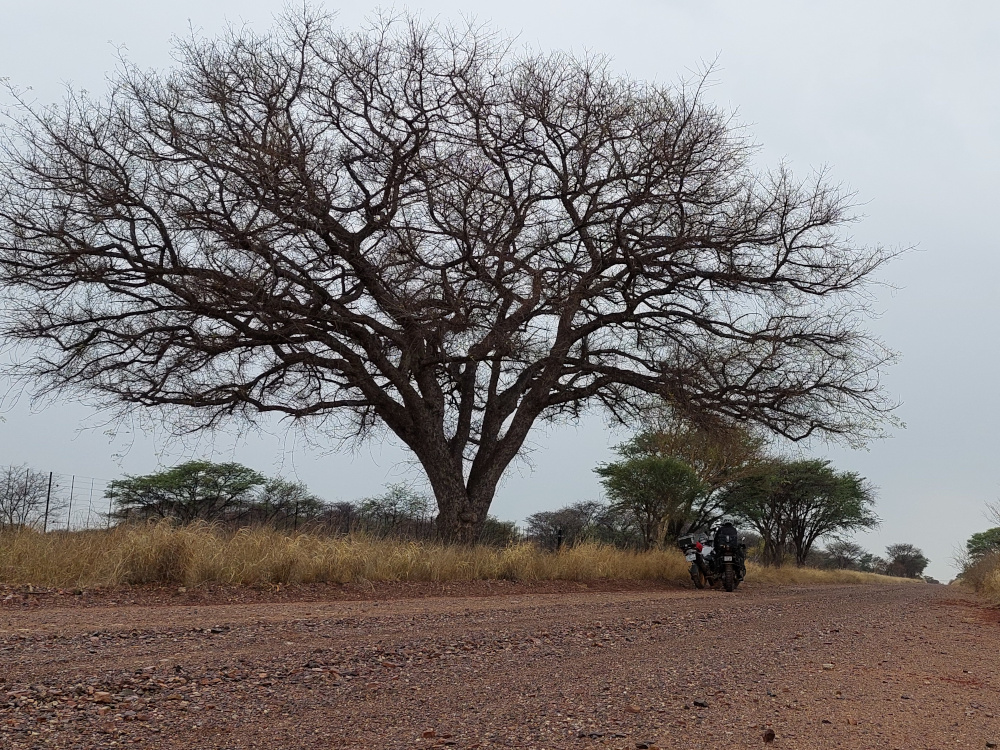
• Because this is game country, it was a challenge to find accommodation. Willem recommends zooming into the Tracks4Africa map to explore the surroundings.
• Top-box lunches were the order of the day as the route runs through remote country where shops are scarce.
• This trip could benefit from an extra day to fully explore the Canal Route. Make time to stop at Beestekraal Stasie, a restaurant decorated with old curios.
Willem’s tips for adventure biking
• Don’t ride alone. There’s a certain allure to riding solo but there’s potential for the situation to become serious if anything goes wrong. Rather go with a small group of people you know well.
• Take a satellite phone or Garmin GPS with InReach technology such as the Montana 700i.
• Pack 2L of water per person and dry snacks to have as emergency food. A space blanket is useful in case you have to spend the night outside. Don’t ride after dark!
• Carry a puncture repair kit and a mini air compressor.
• Most importantly, remember your sense of adventure. You might come across challenging sections, like the sand that sapped our energy. But afterwards it’s these type of experiences that everyone talks about.
